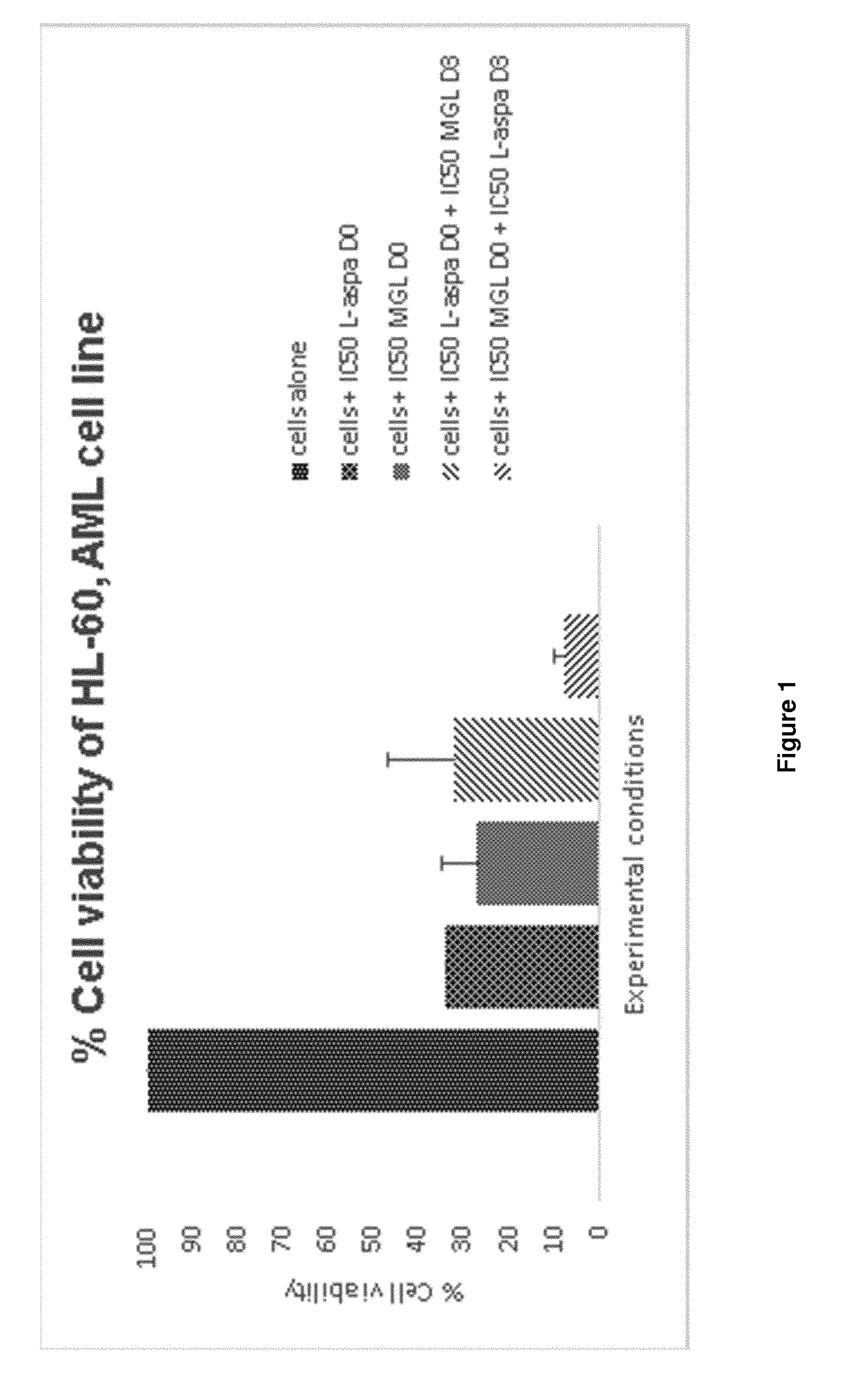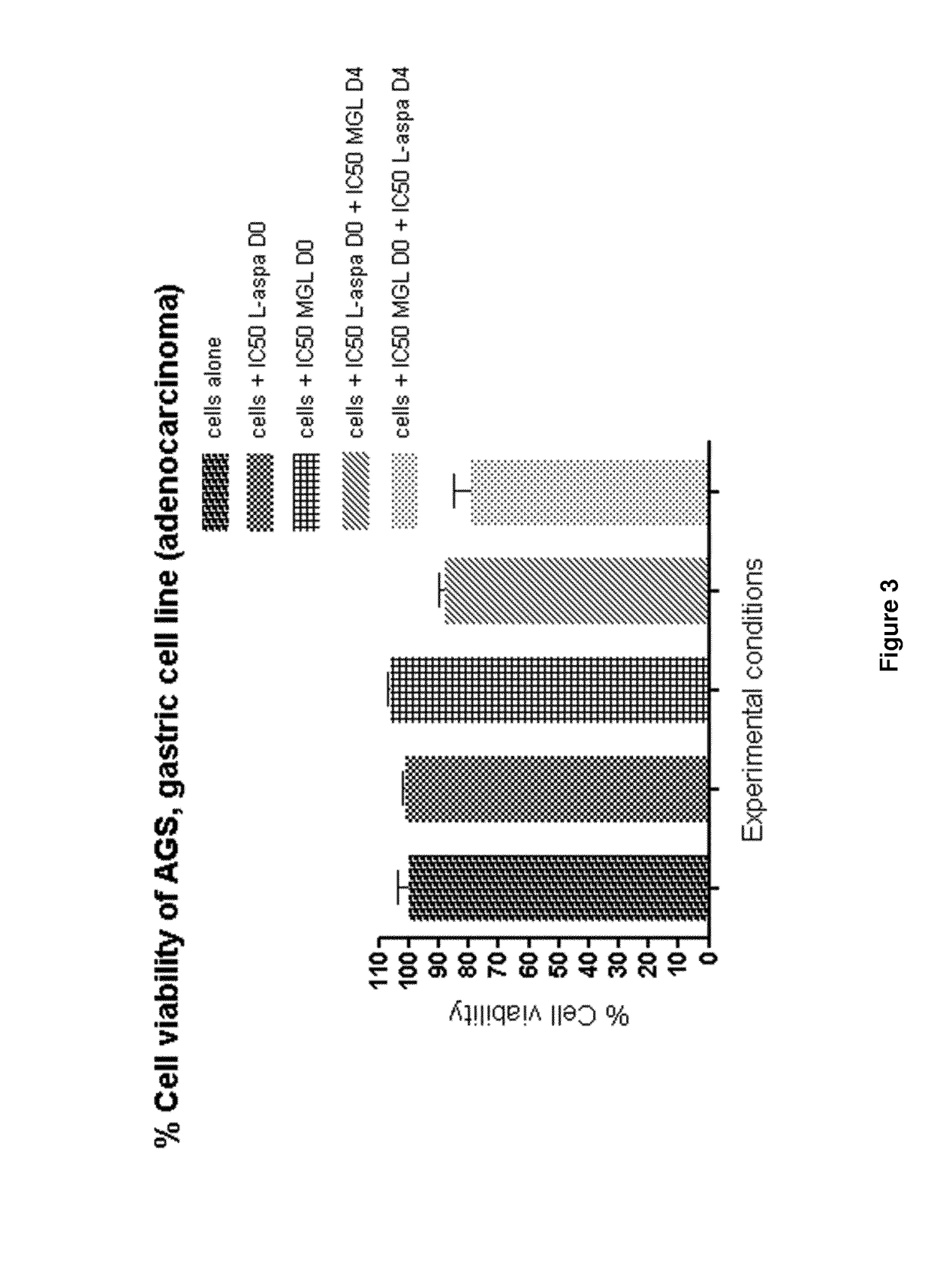Method of treating a mammal, including human, against cancer using methionine and asparagine depletion
a technology of methionine and asparagine, which is applied in the field of mammal treatment, can solve the problems of inability to obtain such an increase in cell mortality in vitro, inherently unpredictable effect of drug combination, etc., and achieve the effect of increasing cell mortality, assessing cytotoxic effects, and increasing cell mortality
- Summary
- Abstract
- Description
- Claims
- Application Information
AI Technical Summary
Benefits of technology
Problems solved by technology
Method used
Image
Examples
example 2
R ENCAPSULATION OF L-ASPARAGINASE IN MURINE ERYTHROCYTES
[0204]The L-asparaginase (Medac®E. Coli L-asparaginase) is encapsulated in murine erythrocytes (OF1 mice) by the method of hypotonic dialysis in a dialysis bag. The blood is centrifuged beforehand to remove the plasma, and then washed three times with 0.9% NaCl. The haematocrit is adjusted to 70% in the presence of the asparaginase, added to a final concentration of 400 IU / ml of erythrocytes or red blood cells (RBC) before starting the dialysis. The dialysis lasts 50 minutes at 4° C. against a lysis buffer of low osmolarity. The murine erythrocytes are then resealed through the addition of a high osmolarity solution and incubating 30 minutes at 37° C. After two washings with 0.9% NaCl and one washing with Sag-mannitol supplemented with bovine serum albumin BSA (6%), the erythrocytes are adjusted to haematocrit 50%. The erythrocytes encapsulating the L-asparaginase are called L-Aspa RBC. The encapsulation generates L-Aspa RBC at...
example 3
TION OF L-ASPARAGINASE IN HUMAN ERYTHROCYTES
[0212]The method described in WO-A-2006 / 016247 is used to produce a batch of erythrocytes encapsulating L-asparaginase. In accordance with the teaching of WO-A-2006 / 016247, the osmotic fragility is considered and the lysis parameters are adjusted accordingly (flow rate of the erythrocyte suspension in the dialysis cartridge is adjusted). The method is further performed in conformity with the physician prescription, which takes into account the weight of the patient and the dose of L-asparaginase to be administered. The specifications of the end product are as follows:[0213]mean corpuscular volume (MCV): 70-95 fL[0214]mean corpuscular haemoglobin concentration (MCHC): 23-35 g / dL[0215]extracellular haemoglobin ≤0.2 g / dL of suspension[0216]osmotic fragility ≤6 g / L of NaCl[0217]mean corpuscular L-asparaginase concentration: 78-146 IU / mL[0218]extracellular L-asparaginase ≤2% of the total enzyme activity. The suspension of erythrocytes so obtain...
example 4
R OBTAINING AND CHARACTERIZING METHIONINE GAMMA LYASE (MGL)
[0219]Production of the strain and isolation of a hyper-producing clone: the natural sequence of MGL of Pseudomonas putida (GenBank: D88554.1) was optimized by modifying rare codons (in order to adapt the sequence stemming from P. putida to the production strain Escherichia coil). Other changes have been made to improve the context of translation initiation. Finally, silent mutations were performed to remove three elements that are part of a putative bacterial promoter in the coding sequence (box -35, box -10 and a binding site of a transcription factor in position 56). The production strain E. coli HMS174 (DE3) was transformed with the expression vector pGTPc502_MGL (promoter T7) containing the optimized sequence and a producing clone was selected. The producing clone is pre-cultivated in a GY medium +0.5% glucose +kanamycin for 6-8 h (pre-culture 1) and 16 h (pre-culture 2) at 37° C.
[0220]Fermentation: the production is th...
PUM
| Property | Measurement | Unit |
|---|---|---|
| composition | aaaaa | aaaaa |
| time | aaaaa | aaaaa |
| concentration | aaaaa | aaaaa |
Abstract
Description
Claims
Application Information
 Login to view more
Login to view more - R&D Engineer
- R&D Manager
- IP Professional
- Industry Leading Data Capabilities
- Powerful AI technology
- Patent DNA Extraction
Browse by: Latest US Patents, China's latest patents, Technical Efficacy Thesaurus, Application Domain, Technology Topic.
© 2024 PatSnap. All rights reserved.Legal|Privacy policy|Modern Slavery Act Transparency Statement|Sitemap



